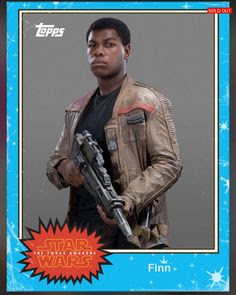In the first article of this series, I talked about Rey's design for Episode VII and how it successfully reflected the character, the situation she was in and the universe it represented. And today I am going to look at how they achieved that with Finn's character.
FINN: THE STORMTROOPER
Finn is a Stormtrooper who deserts the First Order after his first military assault, and he is probably the character that gets the highest number of costume changes (a whooping number of two) only matched by Poe Dameron (who also gets two costume changes).
Being a Stormtrooper, he starts the movie dressed in the iconic Stormtrooper armor.
The design doesn't stray too much from the classic Stormtrooper design of the original trilogy, and while some people might have problems with that, I don't.
 |
| 1977's A New Hope |
And the changes they've done are really logical ones; the suit seems more robust, less flimsy, and the lines are softer, smoother and more aerodynamic. Which is normal considering that it's been 30 years (in-universe). It's only logical that they would have made changes in their uniforms.
For Finn, this suit stands for his "predetermined" personality; what he's been forced to become. And his is, after all, the story of a deserter. So, the first thing he looses is the helmet (the key element that makes every Stormtrooper the same).
His second outfit is a very simple one, it consists of a black undershirt and black trousers. This is actually what he wears underneath the Stormtrooper suit.
This is one of the best things in this movie's design; every costume change is justified by the narrative. This, again, is a big change from the prequels.
The simplicity and nakedness of his black suit are a way to visually present his character. Once he casts aside the Stormtrooper suit (his forced personality) he becomes a sort of a blank slate, which is represented by this simple, average black suit; now he has the chance to become whatever he wants to become.
Finn constructs a new self for himself from what he'd like to be (basically a rebellion fighter, like Poe). And that is perfectly visualized by the final addition to his costume; Poe's jacket. It's a brown leather pilot jacket with washed-out red stripes.
And so, he remakes himself through adopting the look of what he wants to be seen as.
An important element of the jacket that many would make the mistake of overlooking is how run down it looks. It tells a story in and on itself: it's a jacket that has been worn a lot, it has been lived in. That is a key element.
Finn is trying to step into someone else's shoes. He wants to be someone else. And the symbolic weight of using someone else's lived-in jacket is very revealing.
This is a very clever design. Many will think that it's too simple to be such, but, usually, the simpler the design is, the harder it is to do it. So we all should learn not to overlook simple.
Another factor is the fact that, generally, male costumes tend to be simpler than those of their female counterparts.
For me this is a really good design, and, once again, it's very coherent with the original trilogy. It's simple, elegant and very iconic.
Merry Christmas!!
---------------------------------------------------------------------------------------------------------------
If you enjoyed this article and would like to support the blog,
consider buying me a Coffee? 💛💛
If you want more content like this, subscribe! Or come say hi on Facebook, Tumblr, Twitter, Instagram and help us grow!
DISCLAIMER: I claim no credit for images featured on this site unless noted. Visual content is copyrighted to its respective owners, and inclusion here is under fair use for criticism, comment, and news reporting purposes. If you own the rights to content here and wish it removed, please contact me.







Comments
Post a Comment